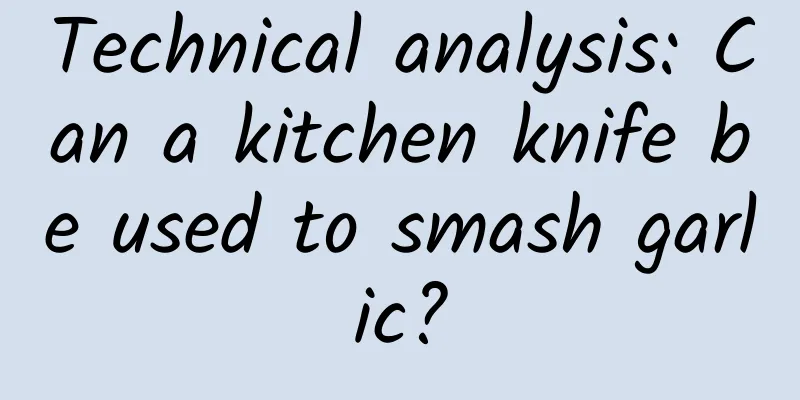Technical analysis: Can a kitchen knife be used to smash garlic?

|
Some time ago, the news that a well-known kitchen knife broke when used to smash garlic caused heated discussion. So, can kitchen knives really be used to smash garlic? As an indispensable tool in the kitchen, toughness is the most basic requirement for a kitchen knife. If it breaks, people may immediately think that there is a problem with the quality of the knife and that it must have been made with shoddy workmanship. Copyright image, no permission to reprint But in fact, the easy breakage of kitchen knives may not have much to do with the materials used, but rather with the type of kitchen knives. Today we will look at the objective reasons behind the breakage of kitchen knives from the perspective of metal materials and metal processing, and hope that this article can provide you with some relevant knowledge on purchasing and maintaining kitchen knives. The whole stainless steel kitchen knife is not actually one piece In recent years, one-piece stainless steel knives (hereinafter referred to as whole-body stainless steel knives or one-piece knives) have become very popular. The so-called one-piece means that the blade and the handle are a whole unit in appearance, that is, the whole body is made of stainless steel. Its benefits are very obvious. Beauty and hygiene are the biggest selling points of this type of knife. The whole body of stainless steel can not only highlight the silvery white metallic luster, but also prevent bacteria from breeding in the wooden handle or even in the seam between the handle and the blade. However, this type of knives actually have a common problem, which is that the probability of the blade breaking as a whole from the handle is much higher than that of ordinary split knives. Why is this? Image source: China News Network In fact, the one-piece knife looks like a whole, but it is formed by welding the blade and the handle together. Many people may wonder why the knife cannot be formed in one step by die forging? For example, if the kitchen knife blank is placed in the mold and stamped, can't it be formed in one piece? This is a very deep question, and in fact, many split knives (which need to be installed with wooden handles) are made in this way. But it must be said that one-piece knives may have to be made separately and then welded. There are three main reasons for this: 1. Although the blade and handle steel may both be stainless steel, the specific grades are generally different. The blade, as the core of the knife, naturally needs to be made of high-grade materials with excellent comprehensive performance, while the handle, as an auxiliary structure, can meet the needs as long as it does not rust under certain conditions, so from a cost perspective, there is no need to unify the materials of the two. Copyright image, no permission to reprint Moreover, many blades are made of so-called three-in-one steel, which is two stainless steel sheets with ordinary steel in the middle. This material can ensure that the kitchen knife has the best comprehensive mechanical properties. Modern kitchen knife factories purchase blade materials directly in the form of steel plates, without the need for the traditional forging process. In order to ensure the efficiency of large-scale assembly line production, the blade and handle have to be manufactured separately. 2. Compared with non-ferrous metals that are easy to process, such as copper and aluminum, the hot working temperature of steel is higher and the work hardening is more significant. To put it bluntly, the energy consumed and the requirements for equipment are much higher. Therefore, kitchen knives are not very suitable for one-piece forming by die forging or stamping. Of course, the individual blade or handle will still undergo a series of machining processes. For example, the blade may be stamped, cut and slightly rolled, while the handle may be stamped or even CNC cut to obtain the desired shape. 3. The welding process that connects the blade and the handle is called heat fusion , which is a very mature process technology. In reality, even if the weld breaks, it rarely causes serious safety hazards. After all, the safety tolerance of kitchen knives and airplanes for sudden breaks is completely different, so many manufacturers are unwilling to spend unnecessary costs on this. In reality, the seam between the blade and the handle is sometimes a straight line (perpendicular to the center line of the handle) and sometimes an oblique line. After hot welding, the appearance is polished, so the weld is often very inconspicuous. The culprit of kitchen knife fracture: residual thermal stress after welding After the above explanation, I believe everyone can understand the necessity of welding the blade and handle of this type of kitchen knife. Compared with the overall structure, the welding part is generally the most vulnerable link, which is completely consistent with our common sense. Not only welding, but also joints such as bonding, sintering, and electronic soldering are generally the first parts to break under external forces. From this perspective, one-piece kitchen knives that need to be welded have inherent structural defects. Therefore, from the perspective of protecting the product and avoiding danger, you should try to prevent the kitchen knife from falling or other situations that may produce a large impact force, so as to avoid the kitchen knife from breaking due to impact. However, some friends may raise questions - the broken position of many kitchen knives is obviously not the weld position, but they are broken at a certain distance from the weld. Does this mean that the above explanations are all untenable? Image source: veer Don't panic, let's take a look at how the welding process works. Before the welding process, the blade has actually completed the key heat treatment process, and has good comprehensive properties, both strong and tough. If such a steel plate is subjected to a small impact force from the side, it is almost impossible to cause a destructive fracture. For example, if we use a kitchen knife to hit a hard rock from the side with a steel plate, it is almost impossible for the product to break unless there are large inclusions or pores in the product. Primary defects such as inclusions or pores should be completely eliminated after the steel plate undergoes a suitable manufacturing process. During welding, due to the high melting point of steel materials, concentrated heating is required to reach a very high temperature near the two welding surfaces, resulting in obvious local softening. There are two reasons why only local heating is needed: 1. The blade has been heat treated as a whole. If it is reheated, the toughening effect of the heat treatment will only partially or completely disappear. 2. Heating the entire weld is not only unnecessary, but also consumes a lot of energy. Generally speaking, factories use various methods such as argon arc welding, local induction, laser, electron beam, etc. to accurately heat the weld. At the same time, pressure is used to bring the two joint surfaces closer to promote the densification of the weld. After the welding is completed and mechanically polished, the weld is already very inconspicuous from the appearance, and from the test strength, the weld is not as weak as we imagined. But why do many blades break in real life? In fact, in addition to the fragility of the weld itself, the thermal stress generated during the welding process is the culprit behind most of the "tragedies". Why is it impossible to eliminate the effects of residual thermal stress? Thermal stress is an intrinsic force within a material. It is easy to generate thermal stress in materials that have been heated or cooled . Its existence is sometimes beneficial or even intentionally imposed, such as in the production of tempered glass. But in most cases, thermal stress is harmful to the stability of the material and needs to be controlled and eliminated. The generation of thermal stress is actually the inevitable result of thermal expansion and contraction of materials . During the cooling process after heating, the steel structure near the heated area will inevitably show a phenomenon in which some parts have a greater deformation tendency than other parts. A kitchen knife is a rigid body with a uniform appearance and a fixed shape, so local internal stress will appear inside the material. In other words, the material is in an inherently unstable state at this time, or in plain language, it is "holding back its energy." This energy will accompany the knife throughout its life cycle, so our kitchen knives not only have a rough appearance, but also a wild heart. Do not underestimate these residual stresses, as they will cause tiny cracks to appear inside the material. If they happen to encounter the right external force, the tiny cracks may instantly expand into devastating fractures. After welding is completed, the stress will be relieved to a certain extent, such as heating again at a lower temperature for a long time to allow the internal stress to balance. However, excessive processing may damage the overall mechanical properties of the material, reducing the hard-earned strength and toughness. Therefore, it is actually impossible to completely eliminate the thermal stress caused by welding. In our daily lives, the sudden explosion of tempered glass is the result of internal stress, and our current tempered glass production process can never completely avoid the occurrence of such accidents (in fact, tempered glass will undergo various rigorous tests before leaving the factory so that products with hidden dangers will not shatter during the testing process). Broken tempered glass Copyright image, no permission to reprint Similarly, stainless steel kitchen knives cannot completely avoid sudden fractures of the blade. As for the location of the fracture, it usually occurs at the weld where the thermal stress is the greatest, of course, it may also occur around the weld, depending on the location of the microcracks and the direction of their expansion. Of course, this does not mean that the one-piece kitchen knife will definitely break, but it means that compared with kitchen knives with traditional structures (the steel in their blade and handle is a piece of material formed at the same time), the welded one-piece kitchen knife is more likely to have the entire blade break. In summary, for companies manufacturing cutting tools, it is necessary to increase welding strength as much as possible and improve the welding process to avoid excessive residual thermal stress. References: 1. The problem of damage to the オールステンレス package https://modama.net/knife/tips23.html Source: This article is produced by Science Popularization China and supervised by China Science Popularization Expo The cover image and the images in this article are from the copyright gallery. The image content is not authorized for reprinting. |
<<: Why do plants grow thorns? The answer lies in the Qinghai-Tibet Plateau
Recommend
What do bidding promoters need to do every day? How to do bidding promotion?
For many friends who have just entered the biddin...
The human immune system does not recognize the existence of the eyeball? About the "immune privilege" of the eyeball
gossip " The eyeball has an independent immu...
OCPM/OCPC, a detailed explanation of the deep conversion dual bidding capabilities
Regarding OCPX, namely OCPC/ OCPM /OCPA advertisi...
What kind of business is talent auction?
Recently, the recruitment field is very hot, and ...
337 billion US dollars! Report says that by 2025, 5G mobile phones will account for more than 50% of smartphone sales revenue
A new study from Juniper Research found that 5G-c...
Zhihu's "Seven-Day Unconditional Refund" disrupts knowledge payment: Come on, let's hurt each other
On that special train to April, to the springtime...
Hemorrhagic fever is clearly the fault of the mice, so why are we not allowed to eat strawberries?
...
Do hummingbirds have Mulan? To avoid being disturbed by their own kind, some females choose to "dress as men"
Produced by: Science Popularization China Author:...
What are the functions of the Guangzhou garbage recycling mini program and how much does the garbage recycling mini program cost?
Since 2019, many cities in China have started to c...
Google I/O Conference: AI as the protagonist, aiming at VR standards
Google's 2016 I/O Developer Conference was he...
Strong winds and cooling temperatures are actually the "pioneers" of high temperatures! North China says to Jiangnan: I'll drink this bowl of "hot" wine first as a token of my respect
1. The cold front will move southward and westwar...
The new benchmark for B station promotion in 2022! (Bilibili case)
How advertisements, works and audiences can "...
A water project connecting north and south, benefiting 140 million people in 7 years
"In ancient times, there were canals for gra...
South Korea takes tough measures against Volkswagen's cheating scandal, executives sentenced to one and a half years in prison
On January 6, local time, the Seoul Central Distr...
If you jailbreak iOS 8, these premium plugins are worth a try
Although there are fewer and fewer reasons to jai...









